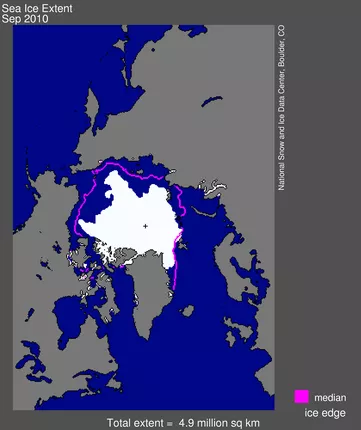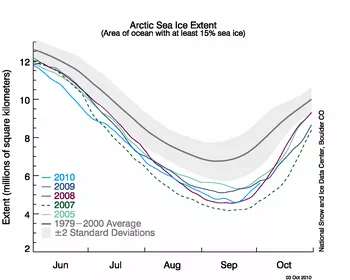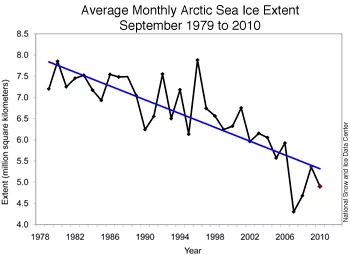This is a press release from the National Snow and Ice Data Center (NSIDC), which is part of the Cooperative Institute for Research in Environmental Sciences at the University of Colorado at Boulder.
Media Relations Contact: press@nsidc.org or +1 303.492.1497
This September, Arctic sea ice extent was the third-lowest in the satellite record, falling below the extent reached last summer. The lowest- and second-lowest extents occurred in 2007 and 2008. Satellite data indicate that Arctic sea ice is continuing a long-term decline, and remains younger and thinner than it was in previous decades.
"All indications are that sea ice will continue to decline over the next several decades," said NSIDC Director Mark Serreze. "We are still looking at a seasonally ice-free Arctic in twenty to thirty years."
Over the summer of 2010, weather and ocean conditions in the Arctic ranged from warm and calm to stormy and cool. Overall, weather conditions were not extremely favorable to melt, but ice loss proceeded at a rapid pace. NSIDC Scientist Julienne Stroeve said, "Sea surface temperatures were warmer than normal this summer, but not as warm as the last three years. Even so, the 2010 minimum rivaled that in 2008—this suggests that other factors played a more dominant role."
The amount of old, thick ice in the Arctic continues to decline, making the ice pack increasingly vulnerable to melt in future summers. While there was an increase this year in second and third year ice, which could potentially thicken over the next few years, the oldest and generally thickest ice (five years or older) has now disappeared almost entirely from the Arctic. This September, less than 60,000 square kilometers (23,000 square miles) of five-year-old or older ice remained in the Arctic Basin. In the 1980s an average of 2 million square kilometers (722,000 square miles) of old ice remained at the end of summer. "While the total coverage of multiyear ice is the third lowest on record, the amount of younger multiyear ice has rebounded somewhat over the last two years. A key question is whether this ice will continue to survive over the next couple of summers, perhaps slowing the overall decline in multiyear ice area," said James Maslanik, a research professor in the Department of Aerospace Engineering Sciences at the University of Colorado, who provided the ice age data.
Arctic sea ice extent on September 19, the lowest point this year, was 4.60 million square kilometers (1.78 million square miles). Averaged over the month of September, ice extent was 4.90 million square kilometers (1.89 million square miles) (Figure 1). This places 2010 as the third lowest ice extent both for the daily minimum extent and the monthly average. Ice extent fell below 2009 and was only slightly above 2008 (Figure 2).
After September 10, ice extent started to climb, apparently signaling the end of the melt season. However, uncharacteristically, it then declined again, until September 19. "The late-season turnaround indicates that the ice cover is thin and loosely packed—which makes the ice more vulnerable both to winds and to melting," said Walt Meier, NSIDC research scientist.
Arctic sea ice follows an annual cycle of melting and refreezing, melting through the warm summer months and refreezing through autumn and winter. Sea ice reflects sunlight, keeping the Arctic region cool and moderating global climate. While Arctic sea ice extent varies from year to year because of changeable atmospheric and ocean conditions, ice extent at the end of the melt season has shown a significant overall decline over the past thirty years. During this time, September ice extent has declined at a rate of 11.5 percent per decade during September (relative to the 1979 to 2000 average) (Figure 3), and about 3 percent per decade in the winter months.
For further analysis and images, please see Sea Ice Today.


